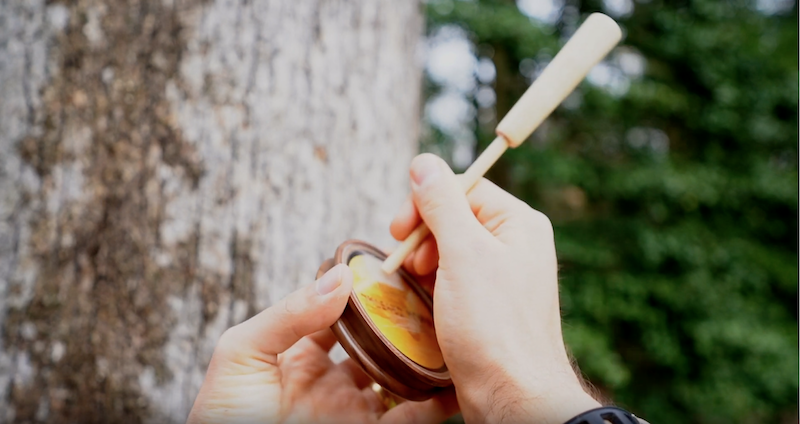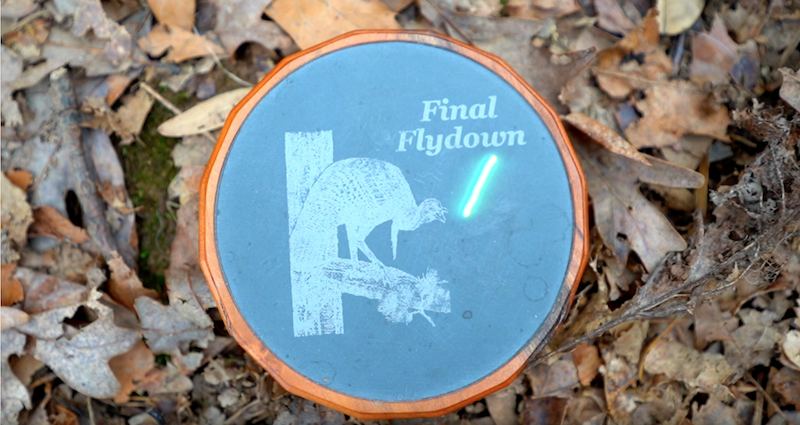For many turkey hunters slate calls are the go-to for replicating almost every sound a turkey makes. With practice the slate’s versatility allows hunters to mimic turkey clucks, yelps, purrs, and cutts to lure in wily toms during spring turkey season. Here is a beginner’s guide to using these essential turkey hunting tools.
What is a Slate Call?
A slate call is a two-piece, handheld caller consisting of:
- A ‘pot’ – The hollow striking surface usually slate but sometimes glass aluminum or polycarbonate.
- A ‘striker’ – The peg used to scratch the pot’s surface to produce sound. Made from wood, carbon, plastic, bone or acrylic.
How to Hold a Slate Call
- Grip the pot in your non-dominant hand, with thumb at 9 o’clock and middle finger at 3 o’clock.
- Hold the striker like a pencil in your dominant hand, with the thumb on top to control pressure.
- Keep the striker perpendicular to the pot’s surface. Adjust the angle slightly to change tone.
Basic Slate Call Sounds
Clucks – Tap the striker on the slate, using medium pressure. Vary volume by adjusting pressure.
Yelps – Draw short oval shapes on the surface with medium pressure.
Purrs – Make long, smooth back-and-forth strokes across the slate. Go slowly for contented purrs.
Cutting – Flutter striker rapidly as if clucking to mimic an agitated hen.
Cackles – Wobble the striker while drawing it to create a wavery, laughter-like cackle.
Advanced Slate Call Tips
- Use less pressure for higher-pitched hen sounds, more for low masculine gobblers.
- Lift the striker slightly between strokes to create a rhythmic yelp pattern.
- Rotate your wrist or whole arm to create variance in pitch/tone.
- Learn to transition smoothly between different calls.
- Mimic real turkey sounds by varying rhythm, speed and pressure.
- Practice calling while concealed to master using the call in hunting situations.
With experience, a slate call allows you to replicate the full range of turkey vocabulary needed to draw in tentative toms.
Troubleshooting Common Slate Call Problems
Squeaking – Use graphite on the striker peg to lubricate. Avoid too much moisture.
No sound – Rough up glazed slate surface with sandpaper or scour pad. Check striker tip for wear.
Distorted sound – Loosen grip on pot to allow vibration. Don’t squeeze striker too tightly.
Can’t transition between sounds – Lift striker slightly off surface between strokes.
Tips for Beginners Learning Slate Calls
Starting out with a slate turkey call can be frustrating. Follow these tips to master the fundamentals:
- Watch videos of champion callers to learn proper technique.
- Listen to real turkeys and try mimicking their vocals.
- Practice daily, even for just 15-30 minutes. Repetition develops muscle memory.
- Try different peg materials like wood, acrylic, or bone to change sound.
- Don’t overcall – Less is often more with finicky turkeys.
- Have patience – Expert calling takes time and experience.
With regular practice, slate calls eventually become second nature. You’ll gain the confidence to use them effectively when hunting.
pairing Slate Calls with Other Types of Turkey Calls
Slate calls produce realistic turkey sounds, but using other call types too can increase success:
- Box call – Easy to use, creates loud yelps/cutts to cover distance.
- Mouth diaphragms – Hands-free, ideal for calling on the move.
- Push-pin calls – Compact, portable friction callers.
- Tube yelper – Produces loud, attention-grabbing yelps.
- Wingbone yelper – Creates authentic sounding high-pitched yelps.
Carry several call types so you can quickly adjust if birds stop responding. Varying calls keeps turkeys guessing.
Customizing and Caring for Slate Calls
To optimize a slate call’s sound, hunters can:
- Shape the sound chamber by drilling holes in the pot.
- Rough up the slate’s glazed surface with 150 grit sandpaper.
- Re-dress the slate periodically with a scour pad.
- Apply chalk to slick acrylic pots to improve traction.
Other slate call care tips:
- Remove peg lubricants before storage to avoid glazing.
- Store in a dry location to prevent warping.
- Wipe surface after use to absorb moisture and oils.
Proper maintenance maximizes a call’s lifespan and performance. Take care of your slate calls and they will call in turkeys for years to come.
Ready to Master the Slate?
Slate turkey calls allow hunters to replicate an astounding variety of realistic turkey sounds with practice. Follow this guide to learn proper holding technique, basic calling, and expert tips that will have you sounding like a pro. Don’t get discouraged—with regular practice, slate calls will become second nature. Before you know it, you’ll be a turkey calling virtuoso, slate in hand.

How to Hold the Call

Hold the pot with your nondominant hand, using the tips of your fingers on its outer rim. The sound comes from the bottom of the pot, so you’ll muffle the sound if you rest the pot in your palm.
Hold the striker as you would a pencil in your dominant hand, and angle it at about 45 degrees to the slate’s surface. If you grip the striker toward the tip you’ll produce higher-pitched sounds. If you hold the striker higher, you’ll produce deeper sounds. Most people find the sweet spot about 1½ inches from the striker’s tip.
Pro tip: Don’t lift your striker off the surface when calling. Keeping it pressed against the surface helps prevent unintentional sounds and produces better sounds.
How to Make 3 Common Turkey Sounds

The Yelp: This common sound is made by hens, the female turkeys. Hens yelp in spring to communicate with toms or gobblers, the male turkeys. To make a yelp, apply light pressure with the striker while making small, tight ovals with its tip. A larger oval produces sounds more like those of a jake or tom yelp.
The Cutt: If a yelp means “hello,” a cluck means, “HELLO!” Hens cluck to get a tom’s attention, which makes the cluck a great call when hunting. Hens usually make several clucks in quick succession. To make a cutt, apply pressure and snap the striker toward you. If you make unintentional squeaks don’t sweat it. Turkeys do the same thing when cutting.
The Purr: Just as cats purr when content, turkeys purr while feeding and feeling secure. This soft vocalization is great for coaxing skeptical toms. To complete the illusion of feeding turkeys, scratch nearby leaves with a stick in between your soft purrs. To make a purr, apply light pressure and drag the striker tip in a straight line. Once you master this call, make a sequence of purrs by changing the striker’s direction.
The best way to learn about turkey sounds is to listen to them. You can hear all of these calls and many others on the National Wild Turkey Federation’s website. Click here to listen. Share this…
Turkey Slate Call 101 | Easy Beginners Instructional
FAQ
Which is better, glass or slate turkey call?
How do you make a Turkey slate call?
Hold the Pot In Your Hand- Use the tips of your fingers to hold the pot away from the palm of your hand. Avoid pressing the call into your palm as most turkey slate calls are designed so that the sound exits out of the back of the call. Grip and Position the Striker- Pick up the striker and hold it just like you would a pencil.
Who are the best custom slate turkey call makers?
There are many great custom slate turkey call makers. Darrin Dawkins, David Halloran, and Brad Roberts are just a few of the big-name pot call makers. Darrin Dawkins has been making calls for over 20 years. One cool thing about his calls is that he offers a 100 percent, money-back, satisfaction guarantee on all his calls.
How do you make a turkey call?
You can make a variety of turkey calls by varying the stroke pattern. All vocalizations require keeping the peg tip on the surface. To cluck, put the peg’s tip on the striking surface. Angle it slightly inward with pressure and pull it toward you. Cluck softly with less pressure; louder and deeper with more.
What strikers go well with slate turkey calls?
Eventually, you will find strikers that pair well with each of your slate turkey calls. If you’re buying a slate turkey call from Amazon, Walmart, or your local sporting goods store, you will likely be buying a production call. This includes brands such as Primos, HS Strut, and Bone Collector.
